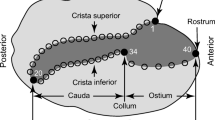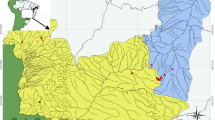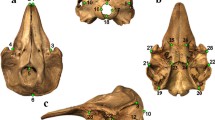Abstract
Patterns of head shape variation in four species of hammerhead sharks of the genus Sphyrna (S. lewini, S. tiburo, S. tudes, and S. zygaena) were analyzed using geometric morphometrics methods. The analysis was performed on the coordinates of 8 anatomical landmarks defined on the basis of external morphology and homologous among the species, reconstructed from distance measurements among the landmarks, using a truss scheme and a modified multidimensional scaling algorithm. The landmark coordinates for each specimen were aligned by generalized Procrustes analysis and entered into a thin-plate splines relative warp analysis. Shape differences among the species were investigated using both the uniform and non-uniform shape components. Canonical variates analysis of the partial warp scores were used to compare patterns of interspecific variation and multiple regression analysis of the shape components on centroid size was used to examine for intraspecific variation.
The uniform components accounted for most of the statistically significant shape differences among the species. There were also differences among species with respect to the non-uniform shape components. The first relative warp depicted a lateral expansion and an anterior compression of the head, whereas the second relative warp displayed a lateral compression and posterior expansion of it. Sphyrna. tiburo and S. tudes were separated from S. lewini and S. zygaena along the first relative warp. The major non-affine shape differences (local deformations) were associated to a relatively larger snout and smaller head in S. tiburo and S. tudes. Significant intraspecific shape changes with increasing size were found for two species, S. lewini and S. zygaena. The largest variation observed with size increase was associated to the uniform compression of the head on its anteroposterior axis and a localized lateral compression of the snout.
No clear evolutionary trend could be unequivocally depicted by the interspecific shape differences, though the results of the geometric morphometric analysis may support the existence of multiple head designs in hammerhead sharks.
Access this chapter
Tax calculation will be finalised at checkout
Purchases are for personal use only
Preview
Unable to display preview. Download preview PDF.
Similar content being viewed by others
References
Bookstein FL (1989) Principal warps: thin-plate splines and the decomposition of deformations. IEEE Trans Pattern Anal Mach Intell 11: 567–585
Bookstein FL (1991) Morphometric tools for landmark data: Geometry and biology, Cambridge University Press, Cambridge
Caldecutt WJ, Adams DC (1998) Morphometrics of trophic osteology in the threespine stickleback, Gasterosteus aculeatus. Copeia 1998: 827–838
Carpenter KE (1996) Morphometric pattern and feeding mode in emperor fishes (Lethrinidae, Perciformes). In: Marcus LF, Corti M, Loy A, Naylor G, Slice DE (eds) Advances in Morphometrics. Plenum Publishing, New York, p. 479–487
Carpenter KE, Sommer HJ, Marcus LF (1996). Converting truss interlandmark distances to Cartesian coordinates. In: Marcus LF, Corti M, Loy A, Naylor G, Slice DE (eds) Advances in Morphometrics. Plenum Publishing, New York, 103–111
Castro JI (1989) The biology of the golden hammerhead, Sphyrna tudes, off Trinidad. Environ Biol Fish 24: 3–11
Cavalcanti MJ, Monteiro LR, Lopes PRD (1999) Landmark-based morphometric analysis in selected species of serranid fishes ( Perciformes: Teleostei). Zool Stud 38: 287–294
Chapman DD, Gruber SH (2002) A further observation of the prey-handling behavior of the great hammerhead shark, Sphyrna mokarran: predation upon the spotted eagle ray, Aetobatus narinari. Bull Mar Sci 70: 947–952
Compagno LJV (1988) Sharks of the Order Carcharhiniformes. Princeton University Press, Princeton, New Jersey
Driver KH (1997) Hydrodynamic Properties and Ecomorphology of the Hammerhead Shark (Family Sphyrnidae) cephalofoil, Ph D thesis, University of California, Davis
Felsenstein J (1985) Phylogenies and the comparative method. Am Nat 125: 1–15
Figueiredo JL (1977) Manual de Peixes Marinhos do Sudeste do Brasil. I. Introduçâo. Caçôes, Raias e Quimeras. Museu de Zoologia da Universidade de São Paulo, Sao Paulo, Brasil
Gilbert CR (1967) A revision of the hammerhead sharks (family Sphyrnidae). Proc US Natl Mus 119: 1–88
Gould SJ, Vrba ES (1982) Exaptation — a missing term in the science of form. Paleobiology 8: 4–15
Harvey PH, Pagel MD (1991) The Comparative Method in Evolutionary Biology. Oxford University Press, New York
Lima MC, Gomes UL, Souza-Lima W, Paragó C (1997) Estudo anatômico comparativo da regiâo cefalica pré-branquial de Sphyrna lewini (Griffith & Smith) e Rhizoprionodon lalandii (Valenciennes) (Elasmobranchii, Carcharhiniformes) relacionados com a presença do cefalofólio em Sphyrna Rafinesque. Revta Bras Zool 14: 347–370
Loy A, Corti M, Marcus LF (1993) Landmark data: size and shape analysis in systematics. A case study on Old World Talpidae (Mammalia, Insectivora). In Marcus LF, Bello E, García-Valdecasas A (eds) Contributions to Morphometrics. Museo Nacional de Ciencias Naturales, Madrid, p 213–240
Loy A, Cataudella S, Corti M (1996) Shape changes during the growth of the sea bass, Dicentrarchus labrax (Teleostea: Perciformes), in relation to different rearing conditions. An application of thin-plate spline regression analysis. In: Marcus LF, Corti M
Loy A, Naylor G, Slice DE (eds) Advances in Morphometrics. Plenum Publishing, New York, p 399–405
Loy A, Mariani L, Bertelletti M, Tunesi L (1998) Visualizing allometry: geometric morphometrics in the study of shape changes in the early stages of the two-banded sea bream, Diplodus vulgaris ( Perciformes, Sparidae). J Morph 237: 137–146
Martin A (1993) Hammerhead shark origins. Nature 364: 494
Monteiro LR (1999) Multivariate regression models and geometric morphometrics: the search for causal factors in the analysis of shape. Syst Biol 48: 192–199
Morrison DF (1990) Multivariate Statistical Methods. McGraw-Hill, New York
Nakaya K (1995) Hydrodynamic function of the head in the hammerhead sharks (Elasmobranchii: Sphyrnidae). Copeia 1995: 330–336
Neff NA, Marcus, LF (1980) A Survey of Multivariate Methods for Systematics. Privately published, New York
Reig S, Doadrio I, Mironovsky AN (1998) Geometric analysis of size and shape variation in barbel from Lake Tana ( Ethiopia ). Folia Zoologica 47: 35–51
Rohlf FJ (1990) Rotational fit (Procrustes) methods. In: Rohlf FJ, Bookstein FL (eds) Proceedings of the Michigan Morphometrics Workshop. The University of Michigan Museum of Zoology, Ann Arbor, p 227–236
Rohlf FJ (1993) Relative warp analysis and an example of its application to mosquito wings. In: Marcus LF, Bello E, Garcia-Valdecasas A (eds) Contributions to Morpho-metrics. Museo Nacional de Ciencias Naturales, Madrid, p 131–159
Rohlf FJ (1995) Multivariate analysis of shape using partial-warp scores. In Mardia, KV Gill, CA (eds) Proceedings in Current Issues in Statistical Shape Analysis. Leeds University Press, Leeds, p 154–158
Rohlf FJ (1996) Morphometric spaces, shape components, and the effects of linear transformations. In: Marcus LF, Corti M, Loy A, Naylor G, Slice DE (eds) Advances in Morphometrics. Plenum Publishing, New York, p 117–129
Rohlf FJ (1999) Shape statistics: Procrustes superimposition and tangent spaces. J Class 16: 197–223
Rohlf FJ (2000) tpsRegr: Shape regression. Department of Ecology and Evolution, State University of New York, Stony Brook
Rohlf FJ (2002) Geometric morphometrics and phylogeny. In: MacLeod N, Forey PL (eds )
Morphology, Shape and Phylogeny. Taylor and Francis, London, p. 175–193
Rohlf FJ (2003) tpsRelw: Analysis of relative warps. Department of Ecology and Evoluti-on, State University of New York, Stony Brook
Rohlf FJ, Bookstein FL (2003) Computing the uniform component of shape variation. Syst Biol 52: 66–69
Rohlf FJ, Loy A, Corti M (1996) Morphometric analysis of Old World Talpidae ( Mamma-lia, Insectivora) using partial-warp scores. Syst Biol 45: 344–362
Rohlf FJ, Marcus LF (1993) A revolution in morphometrics. Trends Ecol Evol 8: 129–132 Rohlf FJ, Slice DE (1990) Extensions of the Procrustes method for the optimal superimposition of landmarks. Syst Zool 39: 40–59
Rüber L, Adams DC (2001) Evolutionary convergence of body shape and trophic morphology in cichlids from Lake Tanganyika. J Evol Biol 14: 325–332.
Sanderson MJ, Purvis A, Henze C (1998) Phylogenetic supertrees: assembling the trees of life. Trends Ecol Evol 13: 105–109
Sokal RR, Rohlf FJ (1995) Biometry: the principles and practice of statistics in biological research. Freeman, San Francisco Geometric morphometric analysis of hammerhead sharks 113
Spjotvoll E, Stoline MR (1973) An extension of the T-method of multiple comparison to include the cases with unequal sample sizes. J Amer Stat Assoc 68: 976–978
StatSoft (1999) STATISTICA for Windows. StatSoft Inc, Tulsa
Strauss RE, Bookstein FL (1982) The truss: body form reconstruction in morphometrics. Syst Zool 31: 113–135
Strong WR, Snelson FF, Gruber SH (1990) Hammerhead shark predation on stingrays: an observation of prey handling by Sphyrna mokarran. Copeia 1990: 836–840
Thomson KS, Simanek, DE (1977) Body form and locomotion in sharks. Amer Zool 17: 343–354
Walker JA (1993) Ontogenetic allometry of three-spine stickleback body form using landmark-based morphometrics. In: Marcus LF, Bello E, Garcia-Valdecasas A (eds) Contributions to Morphometrics. Museo Nacional de Ciencias Naturales, Madrid, p 193–214
Walker JA (1996) Principal components of body shape variation within an endemic radiation of threespine stickleback. In: Marcus LF, Corti M, Loy A, Naylor G, Slice DE (eds) Advances in Morphometrics. Plenum Publishing, New York, p 321–334
Walker JA (1997) Ecological morphology of lacustrine threespine stickleback Gasterosteus aculeatus L. (Gasterosteidae) body shape. Biol J Linn Soc 61: 3–50
Walker JA, Bell MA (2000) Net evolutionary trajectories of body shape evolution within a microgeographic radiation of threespine sticklebacks (Gasterosteus aculeatus). J Zool 252: 293–302
Westneat MW (1995) Feeding, function, and phylogeny: analysis of historical biomechanics in labrid fishes using comparative methods. Syst Biol 44: 361–383
Author information
Authors and Affiliations
Editor information
Editors and Affiliations
Rights and permissions
Copyright information
© 2004 Springer-Verlag Berlin Heidelberg
About this chapter
Cite this chapter
Cavalcanti, M.J. (2004). Geometric morphometric analysis of head shape variation in four species of hammerhead sharks (Carcharhiniformes: Sphyrnidae). In: Elewa, A.M.T. (eds) Morphometrics. Springer, Berlin, Heidelberg. https://doi.org/10.1007/978-3-662-08865-4_8
Download citation
DOI: https://doi.org/10.1007/978-3-662-08865-4_8
Publisher Name: Springer, Berlin, Heidelberg
Print ISBN: 978-3-642-05980-3
Online ISBN: 978-3-662-08865-4
eBook Packages: Springer Book Archive




